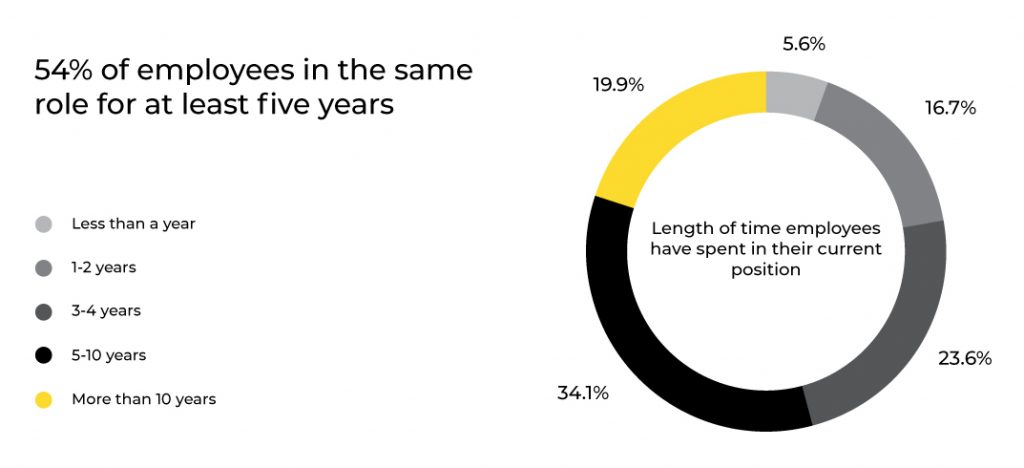Employee Retention Issue in the USA, AU and UK
- Aayush Gupta
- March 25, 2020
- 4 Minute Read

According to the Stanford Center on Longevity Study, employee retention issue wasn’t a big concern 30 years back. Most people used to maintain the same job for years long and were more engaged with their job. However, the business landscape has changed drastically over the years. According to the U.S. Bureau of Labor Statistics, the average tenure of U.S. workers today is just 4.4 years. Moreover, the younger the employee, the more likely he is to switch between organizations.
- The Center for American Progress reports that the average cost of hiring a new employee to fill the void created by an old employee is over 20 percent of the person’s annual salary. This could be millions of dollars for some companies.
- Moreover, a survey from the IML Staff Retention Report says that the average cost of rehiring resources in Australia costs around $23,753. Poor staff retention is one of the main reasons why Australian businesses are facing substantial financial losses.
- The proliferation of employee turnover rates isn’t just a concern in the USA and Australia, but the scarcity of the right talent and the poor retention rate costs UK economy almost £63 billion a year in the total lost GDP. This fades the growth of various startups and small businesses in the UK.
The Rising Employee Retention Issue in the USA
- About 3 million people in the U.S. switch their jobs each month.
- A study on 1,000 U.S. workers reported that about 31% of them opted to quit their job within the first six months.
- About 40 million Americans opted to quit their job in 2018, this represents 26.9% of the total U.S. workforce.

The Rising Employee Retention Issue in Australia
- Approximately 15% or 1.8 million Australian workers chose to quit their job in 2018.
- 67% of Australian employers reported an increase in the staff turnover rate within the last three years.
The Rising Employee Retention Issue in the UK
- 41% of recruiters in the UK are facing challenged due to the high employee turnover rates.
- 33% of UK employers reported difficulties due to poor employee retention rate.
The statistics certainly hint the rising concern for employee retention problems in the US, UK, and Australia. But what are its causes and ways to curb the issue?
Reasons for the Increasing Rate of Staff Turnover in the US, UK, and Australia
- The cost of earning a comfortable livelihood in the USA is growing higher each month and this leads the older US workforce to delay their retirement. This fades the growth opportunities for junior-level employees. 11.7% of employees quit their job due to a lack of growth in an organization.
- The rising U.S. economy is another factor resulting in poor employee retention rate. According to the US Department of Labor, in 2017 the number of job openings exceeded the rate of hires. This gave a boost to the job quit rate as employees were able to find better opportunities more easily. It displays the shift of the crown from the heads of the employers to the heads of the workforce.
- The number of remote jobs is rising in the US and 1/3 US workers would prefer to quit their job for good remote working opportunities.

- The majority of the workforce today is Millenials, and according to the Multiple Generations @ Work survey, 91% of Millennials are likely to switch their jobs within 3 years.
Possible Solutions to Resolve Employee Retention Challenges
1. Provide Employees with a Path to Hone Their Skills
Kevin Griffin, the former CIO of GE Capital said, “Learning cannot just be an afterthought — it must be a core focus of any strong organization.”
Research from the Consumer Technology Association (CTA) reported that high-skills training along with voluntary communication training is among the top factors for retaining employees.
2. Keep Employees Actively-engaged with your Vision
According to a survey, 54% of employees who felt actively-disengaged with their company said they would opt for a new job if they got a salary increase of about 20% or more. On the other hand, the employees who felt more engaged with their job and the organization, the number came down to 37%.
3. Find a Promising Alternative Solution
A majority of businesses switch to outsourcing to escape the hassle of in-house recruitment. Outsourcing projects to a white label service provider can be one solution, but this isn’t the right choice in case businesses want more control over their projects. Instead, a business can opt to build dedicated remote teams or hire dedicated resources.
How Dedicated Team Model Can Curb the Growing Rate of Employee Turnover
More than 50% of businesses globally are facing challenges in retaining their prime employee groups. The dedicated team model can help businesses build dependable resource teams outside their offices, maybe offshore.
How It Benefits Businesses and Agencies?
- No Employee Retention Challenges
When you hire a dedicated team of experts from an outsourcing provider, the team works on the payroll of the provider and he is liable to retain his employees.
- Leveraging the Right Control
Akin to the in-house resources, the dedicated experts follow your work processes and task flow. It makes the dedicated team model a promising alternative for the in-house model.
- Access to Committed Talent
Hiring offshore dedicated resources from developing countries like India, which has a comparatively lower staff turnover rate can help you retain the best talent longer.
- Lower Cost of Hiring New Resources
The increasing issue of employee retention along with the rising average cost of digital experts in the US, UK, and Australia can affect the financial health of businesses. While businesses can hire dedicated experts from countries with lower economy rates at as less as 50% lower than the in-house hiring costs.
To Conclude
Today, 87% of HR leaders consider employee retention as a critical issue for the next five years. With this, 25% of the total US workforce is considered under the high-retention-risk category. Keeping your employees engaged with your company’s goals and vision is one solution to curb the fading rate of employee retention. But businesses need to utilize promising solutions like remote teams and the dedicated team model to keep pace with the ever-growing business competition.

Thank you for submitting the details!
We will keep your information safe. Feel free to contact us with any questions at hello@uplers.com
Please check your email for next steps shared by Robert.


















